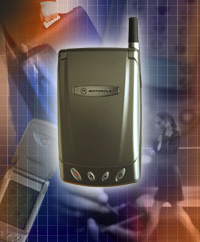 The
Convergence of Phone and PDA Arrives
The
Convergence of Phone and PDA Arrives The
Convergence of Phone and PDA Arrives
The
Convergence of Phone and PDA ArrivesThere are a few of us who need both a mobile phone and a PDA in order to stay on top of complex schedules and multiple tasks. And we have to juggle both devices at once. We clip them to belts, toss them into computer bags, cram them into overstuffed briefcases. A satisfying marriage of the phone and the PDA, though obviously a good idea, has proved elusive to designers--until now. Meet Motorola's Accompli(TM) 008.
This all-in-one phone embraces three of the most important technical/cultural trends of recent years: the mobile phone, the PDA, and the Internet. It's a point of confluence for the tools that have become necessities in our business and personal lives.
The Motorola 008 is a sleek cell phone, to be sure, and its voice capabilities are only the beginning. Open it to reveal PDA functionality and a large (240x320 pixel), grayscale LCD screen. Like your PDA, it has handwriting recognition (a capability developed with proprietary Motorola technology) and a stylus for input; the ability to download additional applications and games; and synchronization with your PC.
An Internet microbrowser rounds out the Motorola 008's functionality by providing an industry-standard interface to the wireless Web. The device is among the first of the new 2.5G (second-and-a-half generation) tools; it provides high-speed downloads and always-on Internet connectivity through GPRS (General Packet Radio Service), the 2.5G upgrade to digital mobile networks using the world-leading GSM (Global System for Mobile Communications) standard.
Speak Now Or Forever Hold Your Peace
Can the phone and the PDA really come together in a productive, efficient, and elegant solution? After all, to join the cell phone and the PDA is to marry communications and handheld functionality. But achieving wedded bliss wasn't easy.
A voice-only wireless phone can be lightweight and very small, its size limited more by the design of the human user than by technology. By contrast, a PDA device is built for digital information and software applications--for putting in, storing, and displaying data. It should accommodate the wireless Internet. The LCD display should be as large as the handheld design can permit.
The trick, then, was to design a device that is both small enough to fit in the hand comfortably and big enough to accommodate a PDA-size screen; adept at voice and data, from a brief chat to a depressingly large to-do list; ready to adapt to anything from the silky voice of a smooth talker to the erratic handwriting of a doctor.
Proven Leader Makes It Happen
Little wonder that Motorola took the lead by delivering this connected handheld, the Motorola 008. The company is a longtime leader and pioneer in the design and manufacture of mobile phones, delivering such cultural icons as the StarTAC(R) phone. Perhaps not so well known is Motorola's key role in the PDA revolution: Its DragonBall(TM) series of microprocessors has been the brains behind Palm(TM) and Palm-compatible PDAs from the beginning.
So it makes sense that Motorola designers took on the challenge of developing a brand-new operating system for the Motorola 008. They were determined not to weld together two unlike devices, but make a statement by creating something new.
"This particular product is a paradigm that we can and should own. It's a perfect marriage between a PDA and cell phone," says Tim Parsey, Vice President Director Consumer Experience Design Organization at Motorola.
In designing this and Motorola's other new mobile devices, Parsey and his team aim to create products that inspire what he calls "object lust"--a feeling among potential users that they must own the device, and that they'll want to show it off.
Attention To Detail
Whether they're trying to create a smaller phone or a larger PDA, designers must always accommodate the needs and preferences of users. Parsey's team includes "human factors" specialists who help strike the proper balance.
"There are certain physical ratios you have to respect," explains Parsey. The distance between a user's ear and mouth is one consideration for cell phones; the size of a user's fingers relative to the buttons is another. "There's a lot of work that goes into getting the right form for each one of these paradigms."
In addition to the sleek clamshell styling, Motorola's designers opted to offer the Motorola 008 in a range of eye-catching hues. "There's a trend toward brighter colors," says Parsey. Color preferences vary by region, so Motorola will offer different sets of colors in different countries.
Such regional awareness is built into Motorola's design process. The company has design centers not only in the US, but also in Seoul, South Korea, and in Milan, Italy--a location that keeps Motorola's designers especially attuned to fashion.
Will the Motorola 008 be the first really successful global offering that combines the cell phone and PDA? Parsey likes its chances.
"We try to design products so they're really just right for their time in the market," he says. Indeed, the first generation of this device, called the Motorola 008, made an auspicious debut in Asian markets.
Motorola's next step: build on the success of the device in Asia and take the Motorola 008 global.
Want to know more about the Motorola 008? You can find information about Motorola and its products, solutions, and services on the World Wide Web at http://www.motorola.com.
Motorola, Inc. (NYSE: MOT)--a leading provider of wireless communications, networking infrastructure, and embedded electronic solutions and services around the world--is focused on making things smarter and life better for people and the environments where they live, work and play.
[ Home | Contact | MobiChat | Experts database | Let's do it ]
Comments to the content of this page can be posted on the MobiChat discussion group